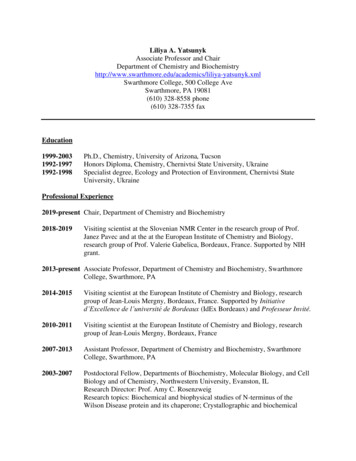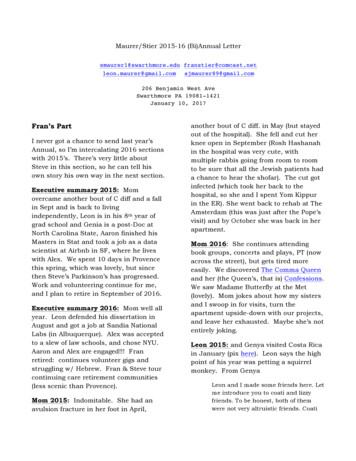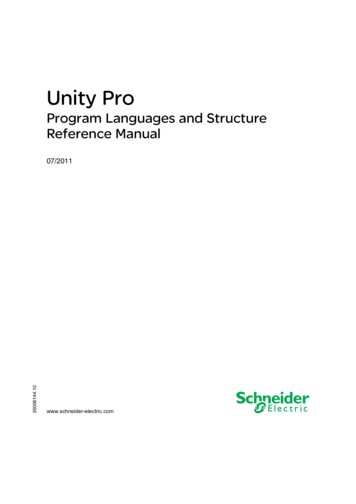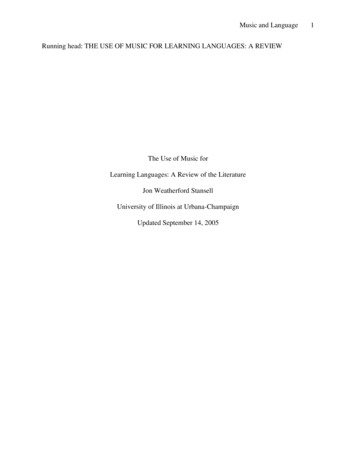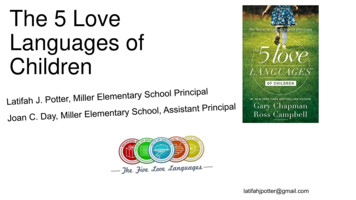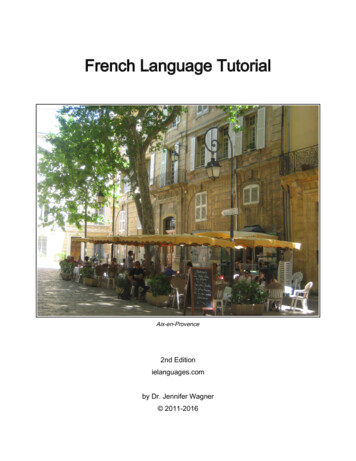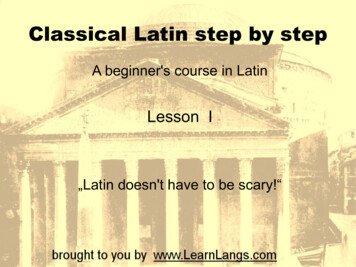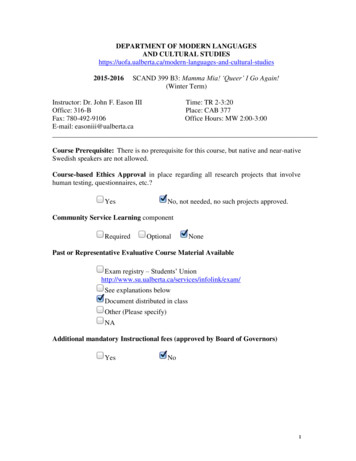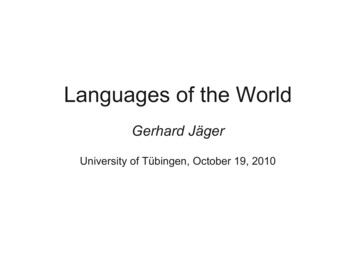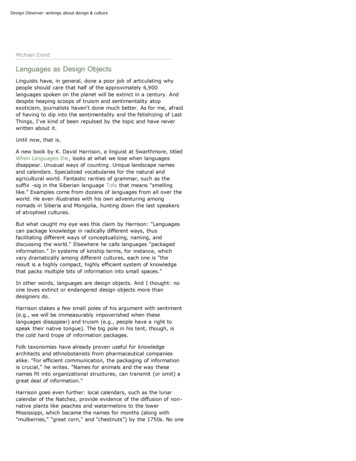
Transcription
Design Observer: writings about design & culture10/17/2007 10:32 AMMichael ErardLanguages as Design ObjectsLinguists have, in general, done a poor job of articulating whypeople should care that half of the approximately 6,900languages spoken on the planet will be extinct in a century. Anddespite heaping scoops of truism and sentimentality atopexoticism, journalists haven't done much better. As for me, afraidof having to dip into the sentimentality and the fetishizing of LastThings, I've kind of been repulsed by the topic and have neverwritten about it.Until now, that is.A new book by K. David Harrison, a linguist at Swarthmore, titledWhen Languages Die, looks at what we lose when languagesdisappear. Unusual ways of counting. Unique landscape namesand calendars. Specialized vocabularies for the natural andagricultural world. Fantastic rarities of grammar, such as thesuffix -sig in the Siberian language Tofa that means "smellinglike." Examples come from dozens of languages from all over theworld. He even illustrates with his own adventuring amongnomads in Siberia and Mongolia, hunting down the last speakersof atrophied cultures.But what caught my eye was this claim by Harrison: "Languagescan package knowledge in radically different ways, thusfacilitating different ways of conceptualizing, naming, anddiscussing the world." Elsewhere he calls languages "packagedinformation." In systems of kinship terms, for instance, whichvary dramatically among different cultures, each one is "theresult is a highly compact, highly efficient system of knowledgethat packs multiple bits of information into small spaces."In other words, languages are design objects. And I thought: noone loves extinct or endangered design objects more thandesigners do.Harrison stakes a few small poles of his argument with sentiment(e.g., we will be immeasurably impoverished when theselanguages disappear) and truism (e.g., people have a right tospeak their native tongue). The big pole in his tent, though, isthe cold hard trope of information packages.Folk taxonomies have already proven useful for knowledgearchitects and ethnobotanists from pharmaceutical companiesalike. "For efficient communication, the packaging of informationis crucial," he writes. "Names for animals and the way thesenames fit into organizational structures, can transmit (or omit) agreat deal of information."Harrison goes even further: local calendars, such as the lunarcalendar of the Natchez, provide evidence of the diffusion of nonnative plants like peaches and watermelons to the lowerMississippi, which became the names for months (along with"mulberries," "great corn," and "chestnuts") by the 1750s. No onespeaks Natchez anymore. Some languages with words forErnest Withers, an AfricanAmerican photojournalistwhose coverage of the civilrights movement in theSouth is second to none,dies at 85. [JH]New York City experimentswith "surface navigation" —gold-on-black compassdecals (24 inches indiameter, larger than alarge pizza but smaller thana manhole cover) toredirect disoriented subwayriders. (Thanks to MichaelBrenner.) [JH]Talking typography with PatSajak and Vanna White.(Thanks to Brian Smith.)[MB]The Kyoto Treaty ofDesign. [MB]Michael BierutWilliam DrenttelJessica HelfandRick Poynor, EmeritusSteven HellerAdrian ShaughnessyDmitri SiegelAlice TwemlowTom VanderbiltLorraine WildTopanga, I Hardly Knew Ye(35)Science and Design: TheNext Wave (8)The Gone World: WallaceBerman's Photographs (14)Rest in Peace, HerbertMuschamp (6)A Plea to The New YorkTimes: Index Your Art (9)David Dunlap at the Timeshas convened a discussionon the controversial newlogo for New York City'staxis. [MB]The Society for DesignAdministration'sCanstruction is adesign/build competitioncurrently being held incities throughout NorthAmerica in which teams ofarchitects, engineers, andstudents compete to designand build giant structuresmade entirely from fullcans of food. (Thanks tohttp://cgi.din.or.jp/ erver.com/archives/024825.htmlSesameVault: Store,encode, and distributevideo however you want viaa simple API.Science and Design: TheNext Wave (JH)Topanga, I Hardly Knew Ye(SH)Design Observer Party:Page 1 of 13
Design Observer: writings about design & culturespeaks Natchez anymore. Some languages with words forcategories called "classifiers" demonstrate how varied the ways ofparsing the world: in Nivikh, a Siberian language with 300speakers, has 27 classifiers; in Squamish, a Pacific Northwestlanguage with 15 speakers, you use a different numberdepending on if you're counting humans or animals."Of course these languages are endangered!" someone willinevitably crow. "English or the other major languages areinformationally more efficient!" This isn't true. For example, whatinformation is encoded in the English "my nephew"? For sure, it'sa male person. But (as Harrison writes) "is he related to me byblood or marriage? Unclear. Is he older or younger than me?Unclear. Is he the son of my sister or my brother? Unclear. Is hethe son of an older sibling of mine or a younger sibling? Unclear.Is he a boy or a man? Unclear." Taken in absolute terms, Englishisn't so efficient: we'd need a separate book to list all its majorinefficiencies.One drawback of When Languages Die is that Harrison goes backand forth between "knowledge" and "information;" surely theseare part of a folk taxonomy that every 21st century Americanacademic should know cold. He doesn't nail the "so what?"question, either. But it doesn't really matter. This book hasenough detail for a sympathetic reader to fill in the blanks.But let me take the information-language connection to the nextlogical step: how do you manage a language as intellectualproperty? This is not as absurd as it sounds: last year theMapuche, an indigenous group in Chile and Argentina, suedMicrosoft for not consulting them when their language,Mapuzugun, was included in a foreign language pack for WindowsXP. Approximately 300,000 people speak the language, enoughpeople for Microsoft to justify getting involved. There arenumerous nuances to consider here, many of which have beendiscussed by linguists at Language Log.At one level, this is absurd. How can you protect a language, andwho would own it? Yet if we grant David Harrison his argument,perhaps that's exactly what the speakers of an endangeredlanguage should do to protect it: learn how to manage theirinformation packages better.Michael Erard has written in The New York Times, Wired, Slate,and The New Republic about language at the intersection oftechnology, policy, law and science. He has an MA in linguisticsand a PhD in English from the University of Texas. His bookabout verbal blundering, titled Um., will be published byPantheon later this year.05.08.07 PERMALINK DEL.ICIO.US DIGGComments (28) JUMP TO MOST RECENT COMMENT You probably know about the Rosetta Project, affiliated with theLong Now Foundation and dedicated to preserving languages.http://www.rosettaproject.org/10/17/2007 10:32 AMcans of food. (Thanks toJudy Baskin.) [JH]Design Observer at no. 14for the People's DesignAward. Vote today: contestends tonight at midnightEST. [WD]Out this week, and not aminute too soon: Designfor Democracy: Ballot Election Design by MarciaLausen, published by AIGAand University of ChicagoPress. [MB]Pop!Tech 2007 will bewebcasted live between9:00am and 6:30pm ESTfor three days starting onOctober 18. [MB]This is New York, a crazytv commercial by MotionTheory featuring a remix ofElla Fitzgerald's 1957version of "Take the ATrain." Yes, that is a giantpizza slicer rolling downYankee Stadium's thirdbase line. (Thanks toJennifer Kinon.) [MB]The final presentation atAIGA Next by Microsoft'sBlaise Agüera y Arcas wasmindblowing, with twoextraordinary demos:Seadragon permits thedisplay of vast amounts ofinformation on a singlescreen, with infinitezooming capability andrazor-sharp resolution;Photosynth enables theconstruction of complex 3Dimages from hundreds ofdiverse photographicsources. Unless you own aMac, at least for now. [MB]Daniel Huppatz launchesCritical Cities with a criticalappraisal of the NYC'sMeatpacking District (andTibor Kalman's RestaurantFlorent). [WD]The Wall Street Journaltracks the fortunes ofGeorge W. Bush in itshttp://cgi.din.or.jp/ erver.com/archives/024825.htmlDesign Observer Party:Denver, October 12 (TheEditors)Rest in Peace, HerbertMuschamp (MB)A Plea to The New YorkTimes: Index Your Art(WD)Wood That We Could (WD)Stan Brakhage: Caught onTape (JH)Burma (Myanmar), 1989(WD)Decorative Books: The Endof Print (SH)May I Show You MyPortfolio? (MB)searchBrowse the Archive AdvertisingArchitectureArtBooksBrandingCities & PlacesCultureDesign HistoryEducationFilm / VideoGraphic DesignHistoryIdeasInformation DesignInternet / uaryObservedOtherPhotographyPoliticsProduct DesignProfessional TheatreTheory / CriticismTV / RadioPage 2 of 13
Design Observer: writings about design & culturePosted by: John C on May 8, 2007 12:41 PMDelishious.Hugely interesting, and well pointed out, but not very suprising;that each language contains a unique way of interpreting theworld. I speak a couple of 'odd' languages. translation is terror!I simoultaneously pity and envy people who have only english(some of them say they speak another language, but when pushcomes to shove.)I smiled through the whole article, many thanks- I shall surelyhave a closer look at Harrisons book, and your too whenavailable.Posted by: ms norway on May 8, 2007 12:44 PMI agree and can relate to Erard's points. My own native tongue ofTelugu, spoken in a state in southern India called AndhraPradesh, is one such language. While it is still spoken by many,everyday spoken Telugu continues to add more and more Englishwords to the mix. This is not because it is an easier or moreefficient language—English is just more widespread because ofthe power and influence of its native nations. In fact, Telugu ismore precise in dealing with familial terms than English. We haveseparate words for big sister (akka), little sister (cheli), bigbrother (anna), and little brother (thamadu). The same goes forthe terms for aunts and uncles, which are differentiated bymother's or father's side as well as age in relation to yourparents. Some words even show a bit of our old culturaltraditions and practices; for instance there are certain cousinsyou are allowed to marry (like your father's sister's kids, or yourmother's brother's kids). These cousins have different terms thanthe cousins you can't marry. Pretty precise, huh? And as thesaying goes, Eskimos have a hundred names for snow, so doIndians have several names for rice at its various stages, sincerice is a staple crop and is embedded in our diets. Then there aresome words you can never perfectly translate into English. Thereis a single word in Telugu which could roughly translate into"joyous chatter,"or the boisterous, happy noise that waftsthroughout the house when relatives and friends are visiting.Such words are an insightful look into the culture behind thelanguage.I was born in the US but my parents are from Andhra Pradesh,India, so I didn't learn Telugu growing up but instead workedhard to learn it as an adult. I always find it funny when I visitIndia and use a new word I learned from a Telugu-Englishdictionary, only to be met by a bemused expression and told thatno one uses that word anymore. I know languages can bebarriers, but there's something beautiful in the way they preservea culture. That's why it was so important to me to learn mynative tongue.Posted by: Swathi Ghanta on May 8, 2007 01:08 PMI think you've got it the wrong way round. Language is not'design', design is a language. See how linguistic theory has beenused to explain how meaning is produced and then applied to10/17/2007 10:32 AMGeorge W. Bush in itshedcuts. (Thanks toChristoph Niemann.) [WD]TV / RadioTypographyIn Barcelona, statues thatquestion an observer'ssense of reality. [JH]Maira KalmanCharley Harper &Todd OldhamCharley Harper: AnIllustrated LifeThrough October 27 in NewYork: Alphabet is anexhibition of hand-drawnlettering and experimentaltypography. [JH]KristineMcKenna &Lorraine WildWallace Berman:PhotographsLike you needed one morereason to procrastinate:free internet TV is here.(Thanks to MichaelBrenner.) [JH]Michael ErardUm. . .: Slips,Stumbles, andVerbal Blunders,and What TheyOne more: AIGA Nextaccording to Core77. [MB]Why restating the brief isnot the same as solving theproblem. Jon Stewart cuesup a demonstration by ourfirst meta president,George W. Bush. (Thanksto Joe Coates and KevinSmith.) [MB]MeanJonathanBarnbrookBarnbrook BibleAshley GilbertsonWhiskey TangoFoxtrot: APhotographer'sChronicle of theUnbeige has the report onthe Design Observer party.[MB]A great podcast interviewwith newly-mintedsuperstar Marian Bantjes atBe A Design Group, whereNate Voss is also doingsome fun coverage of theAIGA Next conference.[MB]Of course, it's sold out, butyou might like to know:Maira Kalman returns tothe New York Public Librarynext week to discuss herwonderful new book ThePrinciples of Uncertainty,based on her belovedmonthly feature in The NewYork Times, including thedebut of songs based onquestions in the bookcomposed by theremarkable Nico Muhly.[MB]http://cgi.din.or.jp/ erver.com/archives/024825.htmlIraq WarGuy SchraenenVinyl Records andCovers by ArtistsAnne KreamerGoing Gray: What ILearned aboutBeauty, Sex, Work,Motherhood,Authenticity.Cynthia SmithDesign for the Other90%John MaedaThe Laws ofSimplicityStuart Bailey &David ReinfurtPage 3 of 13
Design Observer: writings about design & cultureused to explain how meaning is produced and then applied todesign.The nature of languages seems to me to be accidental - nothingseems to happen 'by design' and
calendar of the Natchez, provide evidence of the diffusion of non- native plants like peaches and watermelons to the lower Mississippi, which became the names for months (along with "mulberries," "great corn," and "chestnuts") by the 1750s. No one speaks Natchez anymore. Some languages with words for Ernest Withers, an African-American photojournalist whose coverage of the civil rights .
